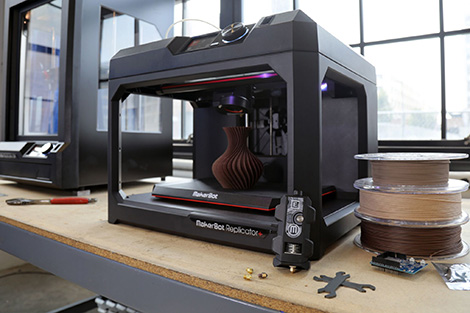
A MakerBot Replicator+ with updated hardware, allowing it to print in ColorFabb filaments with abrasive fills
MakerBot has announced the launch of its new experimental platform, MakerBot Labs, which aims to allow advanced users to experiment with software and materials.
Not quite a full ‘step-back’ towards the company’s open source routes, the announcement was explained further in an interview with Makerbot CEO Nadav Goshen [see bottom of article for interview in full], who stated that it is introducing this new, “more open platform as a direct response to our advanced users calling for greater freedom with materials and software”.
MakerBot Labs includes new customisable hardware and software with open APIs, and custom print modes for MakerBot Print – targeting those wanting some serious aftermarket upgrades.
Theses include its Tough PLA material that requires a unique extruder and unique set of print settings in order to certify its performance, or its partnership with Autodesk to offer cloud-based 3D printing directly from Tinkercad.
The MakerBot Labs Experimental Extruder has been designed for the advanced user looking to push the limits of what’s possible with MakerBot 3D printers.
Featuring an easy swap-out design, with a modified thermal core, more secure thermal barrier tube and interchangeable nozzles, it accepts a wide range of 1.75mm filaments, including the ColorFabb range bronzeFill, copperFill, corkFill and woodFill.
Full interview with MakerBot Labs CEO Nadav Goshen
What does this new platform mean for MakerBot?
This release marks another stage of MakerBot’s growth and 3D printing leadership. MakerBot built the industry’s first desktop 3D printers, then the first fully connected 3D printers, and most recently launched solutions for Educators and Professionals that go much wider than our hardware offering.
Focusing on these customers’ needs, we learned that the main barrier to wider 3D printing adoption was the lack of a reliable and easy to use solution.
Now, after setting the industry standards for what makes a quality and reliable 3D printing experience, we’re introducing this new, more open platform as a direct response to our advanced users calling for greater freedom with materials and software.
This comes as an added option to our advanced users who are looking to experiment, but still need the industry’s best reliability out of the box.
MakerBot is especially proud to offer the flexibility and experimentation that MakerBot Labs adds to our existing solutions.
Does this mean MakerBot is moving back to open source?
We’re taking a step towards openness by offering an experimental platform that allows developers and engineers to interact with our technology, governed by an open API.
It’s definitely in the spirit of what the tech community refers to when they mention “open source” – a collaborative platform that allows the community to improve on a product and its experience.
The best way to offer the freedom to customize and improve on our solutions is to offer an alternate, parallel experience that the user can enter in and out of according to their needs. That’s MakerBot Labs.
Ensuring the highest quality experience with our products is what led us to build fully supported solutions, and bringing our users the best possible experience is the lighthouse that we will continue to follow.
Will MakerBot license its code as open source?
Open source licenses take many forms and are not governed by a single definitive community or body. Some won’t allow commercial usage, but others will.
Some require all derivatives to follow the same licensing, while others will only require the additions to be open – and so on. We’ve chosen to open our platform with an API governing access to it, we are not changing our licensing policy.
Why only enable some modifications? Why not open the system entirely?
Our products are a combination of highly integrated systems, and in order to maintain a high level of performance and quality, each component has to be optimized to interact with each other.
That optimisation and quality depends on close control and predictability, which requires us to be very selective about the parts we open.
However, we heard our users calling for greater flexibility in print setting, types of materials, etc., so we identified the best places to add that flexibility that won’t compromise the reliability of our solutions as a
whole. This way, users can shift back and forth between a reliable, controlled workflow and MakerBot Labs, a sandbox with the freedom to experiment.
What else can we expect from MakerBot Labs? Will MakerBot open more software and hardware in the future?
We will continue to build on our current solutions to offer the best possible experience for our users.
In some cases this experience requires a high degree of control. Take our Tough PLA material for example: it’s a specifically formulated material that requires a unique extruder and unique set of print settings in order to certify its performance – that’s quite a bit of control.
In another example, we opened our cloud printing APIs to third party developers, and recently partnered with Autodesk to offer cloud-based 3D printing directly from Tinkercad, a popular in-browser 3D design tool – which is quite a bit of freedom.
Our users can expect us to continue leading the 3D printing industry with innovative, fully supported 3D printing solutions, and we believe this balance between experimentation and reliability is an important part of those solutions.






